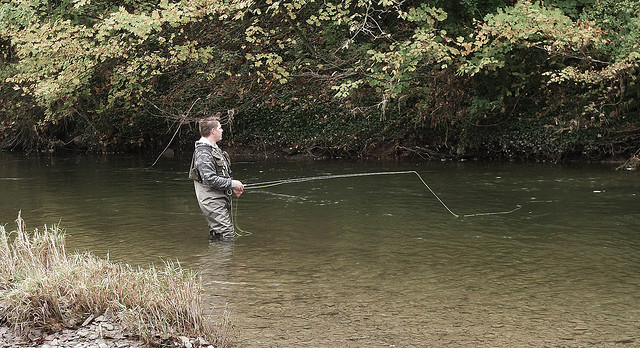Get the waders and rods ready: warm March weather may spur an early emergence of the aquatic insects that trout love to eat.

Fly anglers may see rising trout earlier than usual with the warm weather bringing insects out. Photo: kasperbs (Flickr)
With temperatures in much of the Great Lakes region approaching 70 degrees, the internal clock of certain mayflies and caddisflies could signal that it’s time to get out of the water earlier than usual.
Caddisflies are small moth-like critters and mayflies are in the dragonfly group of insects. Trout-seeking fly anglers often use lures that imitate them.
And Richard Merritt, a professor of entomology at Michigan State University, predicts that there will be an early emergence of both.
“The life cycle is based on heat over time,” Merritt said. “Once they gather enough heat units in their bodies, they’ll move on to the next stage. If it’s warm they’ll emerge.”
The insects lay their eggs on stream surfaces in the summer or fall of the previous year.They sink to the bottom where they hatch. Most of their larval growth takes place during the winter months — no matter how cold it gets. After a certain amount of warm weather they emerge.

A type of mayfly. Photo: Mike E. Talbot (Flickr)
And for those who make their living chasing trout, the early spring means reaching for the Mahogany Dun #16 and Blue Winged Olives #18 a bit earlier.
“You just have to be versatile,” said Matt Verlac, a fly fishing guide from Gates Au Sable Lodge in Grayling, Mich. “The hatches are always different … sometimes they are early … sometimes late.”
It’s not all good news, especially if earlier warm weather becomes more common.
Merritt said climate change could make early insect emergence common, which would change ecosystem cycles — sometimes for the worse.
“If the insects come off early because of heat and then it snows or freezes, it could kill off all of their eggs when they reproduce,” he said.
He also said migrating birds and other predators that depend on emerging insects for food might not be able to adjust to the different timing.
It’s not just the fly anglers’ favorite insects that could emerge earlier, but the stinging, annoying bugs too.
“I expect an early black fly season in the Upper Peninsula, and mosquitoes to come off earlier too,” Merritt said. “Which mean biting people earlier too.”
The early spring comes on the heels of a mild winter, so the snowpacks that feed rivers are either already gone or going away quickly, said Bryan Burroughs, executive director of Michigan’s Trout Unlimited chapter.
Burroughs said this may be good for spring anglers but could hurt summer fishing.
“With less snowpacks the rivers will get to lower levels pretty quickly … in the spring bugs will crawl around and it will kick things into gear faster,” Burroughs said.
But trout and salmon are cold-water fish and if summer water temperatures are over about 70 degrees it stresses them out, Burroughs said. The warm water increases their metabolism and need for oxygen, while water’s ability to hold oxygen decreases when warmer.

Caddisfly larva. Photo: http://gfp.sd.gov
Precipitation plays a role in hatches too, said Mac Strand, an associate professor in Northern Michigan University’s biology department.
Aquifers at stream and river headwaters regulate temperatures — keeping them cooler in the summer and warmer in the winter. This is because groundwater stays at about the local annual average air temperature throughout the year.
Aquifers are like a sponge, Strand said. Once the sponge is full, it will discharge. So increased precipitation could regulate stream temperatures combating abnormally warm temperatures.
Despite the unpredictability, Verlac said business goes on regardless of what the weather throws at him.
“If anything it’s a good thing, especially for us guides who make a living off of this,” Verlac said. “It just means our season is longer.
“Fish are always in the river. You just have to figure out how to catch them.”
Verlac said the biggest challenge is getting the word out to would-be lodge visitors. The lodge sent employees to a Detroit-area fly fishing show two weeks ago to warn anglers that hatches may be earlier than usual.
Some people book their trips a year in advance though, Verlac said. This means one thing: adjust.
“Sometimes people are looking for Drakes and getting Hex,” Verlac said. “Sometimes they’ll catch the tail end of a hatch that they drive up for … but that’s just part of fishing.”
